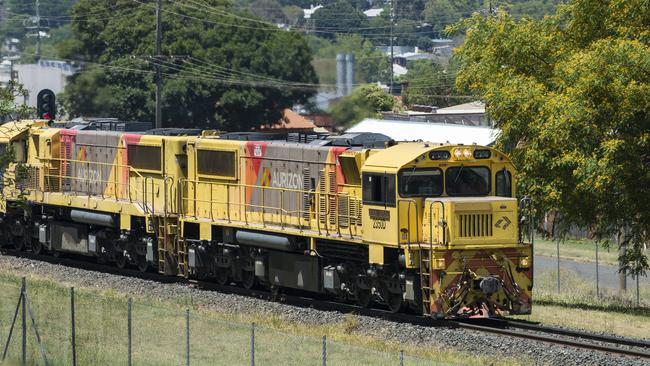Aurizon boss Andrew Harding says Darwin can become a major port under a ‘landbridge’ strategy
The Port of Darwin in Australia’s Top End will become a major shipping import destination if Aurizon gets its way.

Aurizon wants to turn the Port of Darwin into a major shipping terminal, outlining an ambitious plan to turn its rail haulage business into a “land bridge” to haul shipping containers from regional ports across northern Australia and attract shipping lines away from ports in capital cities.
Aurizon outlined its new strategy at its investor day on Tuesday, saying it believed spending money to build its presence at the Port of Darwin would help the company diversify away from coal and build an Australia-wide haulage business that would help importers avoid the ports at Sydney, Melbourne and other major cities.
Managing director Andrew Harding told analysts and shareholders the so-called landbridge strategy could more than double the company’s shipping container business by the end of the decade, reducing Aurizon’s reliance on coal haulage in Queensland and NSW, and help the company build a new business based on attracting shipping lines to the Port of Darwin, where the company is establishing its own docking and unloading services.
Aurizon has the capacity to move 350,000 twenty-foot equivalent units across the country each year, including 150,000 TEUs on the Adelaide to Darwin rail line, the company says.

Mr Harding told analysts the company planned to build that business to 450,000 TEUs by 2025 and had an “aspirational” goal of up to 750,000 TEUs by 2030.
“This offering is anticipated to be at cost parity on a delivered basis to the east coast when compared with current shipping methods. Therefore, we will be initially targeting those freight forwarders seeking a solution between traditional sea freight and costly airfreight,” he said.
“As many of you would be aware, the land-bridging concept was part of the original plans for the Alice Springs to Darwin line when constructed twenty years ago.”
Aurizon did not say how much of that volume it expected to move through Darwin but noted it also had facilities at regional ports at Townsville, Gladstone and Newcastle. The Port of Darwin moved only 20,696 TEUs last financial year, according to its website, with 11,482 imported and the rest export containers.
But, by attracting shipping lines to Darwin, the company says it could cut delivery times to major metropolitan centres by up to seven days, arguing it could deliver the goods via rail for the same price as using international ships would cost. The company copped plenty of questions from sceptical analysts on its plans, however, which will cost $325m this financial year as Aurizon installs new cranes in Darwin to build its own unloading facilities.
Normal container ships plying international routes can typically carry 8000 to 10,000 TEUs, with the biggest carriers capable of moving 24,000 TEUs.
A double stacked freight train 1.8km long typically carries up to 330 TEUs, meaning it would take 25 trains to shift the cargo of a typical 8000 TEU ship.
In response to analyst questions, Aurizon containerised freight boss Gareth Long said the Port of Darwin could take only smaller container ships with its current infrastructure – those capable of carrying about 4000 TEUs. But Mr Long said the company’s initial business pitch would be for even smaller ships carrying 1000 to 2000 TEUs.
The landbridge idea was a central feature of the completion of the rail link between Adelaide and Darwin, which kicked off in 1999, with the line opening in 2004. But the idea has never taken off, restricted by costs and low volumes. The original operator of the line, Freightlink, went bust four years after the line opened, weighed down by the cost of the debt taken on to build the $1.2bn rail line.
Its assets were acquired by Genesee & Wyoming Australia for $334m in 2010, including the right to operate the lines.
Aurizon paid $2.3bn for One Rail, including those assets – and a coal haulage business – in 2021.
But Mr Harding told analysts that times had changed and Aurizon’s market soundings had indicated significant market interest in the idea, given the change in consumer behaviour during the Covid-19 pandemic.
“The world changed. Ordering things online and things arriving in packages. And you’ve got congestion on the east coast as the population has driven up the overall demand and the online ordering effects have led to congestion at major ports,” he said.
Aurizon shares closed down 20c, or 5 per cent, to $3.80 on Tuesday.


To join the conversation, please log in. Don't have an account? Register
Join the conversation, you are commenting as Logout